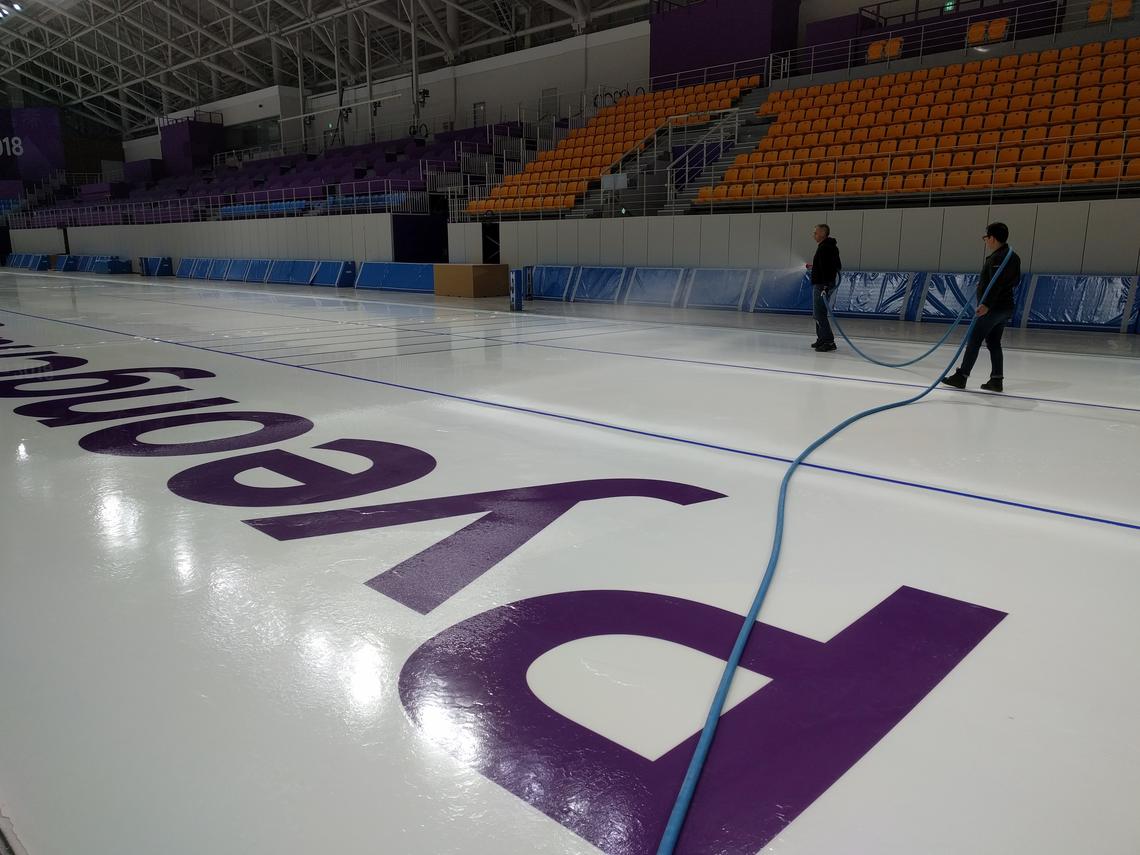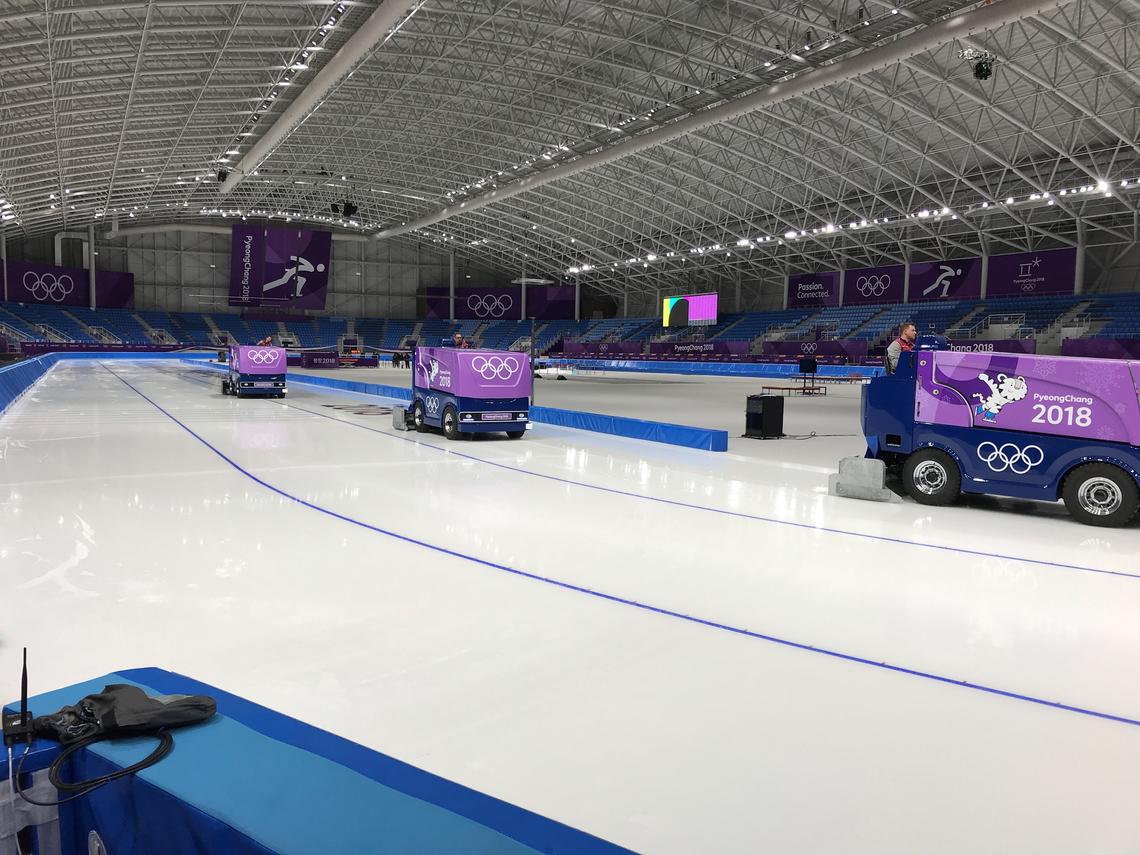Feb. 15, 2018
Olympic Oval icemakers share their talent for prepping fast ice at Pyeongchang Games

It's a scrapbook kind of moment. Cracking open the local newspaper and seeing a photo of Tiger Woods in the sports section — right beside a picture of you driving a Zamboni.
That display in a Korean publication, more than a year ago, had been an early and surefire indication of the importance of speedskating at the 2018 Olympic Games in Pyeongchang, South Korea. Even the arrival of icemakers from Calgary — such as Luke Janetzki and Brandon Hogberg, subjects of the aforementioned photo — was considered big news.
"It’s funny," Janetzki, one of the Olympic Oval's highly regarded representatives, said in a recent email exchange. "I can’t read what (the newspaper) says in Korean but … it’s certainly a high-profile sport for Korea.
"Skating is very big over there."
Which is why, three years ago, the Pyeongchang Organizing Committee had selected the Olympic Oval's icemaking experts to make and maintain the long-track surface at the Winter Games.

Yves Hamelin is justifiably proud of his Olympic Oval team's fame for preparing fast ice.
Luke Janetzki
"Our team has been known for a long time (for its ability) to prep the fastest ice in the world," says Yves Hamelin, director at the Olympic Oval. "We are very … I would say, almost famous, for supplying fast ice. Our expertise is unique and now we are sharing it with other countries."
During the Olympics, the busy speedskating track features training in the morning and afternoon. Racing takes place in the evening. The Oval gang, however, is unfazed by the demands.
"We started with a bare concrete floor," Janetzki said of the multi-year production, "and will continue to be hands-on until the last skater crosses the finish line."
The hectic schedule necessitates the formation of two work shifts for the eight men, including famed icemaster Mark Messer from the Olympic Oval. (Meanwhile, other staffers have stayed put to look after the Calgary track.)
"Crazy long days (in PyeongChang), from early in the morning till late at night," says Hamelin. "Maintaining the ice and keeping it in optimal condition, the guys will finish their days at midnight or one o'clock in the morning, sometimes two o'clock in the morning."

The Olympic venue got a test drive a year ago and the ice passed with flying colours.
Luke Janetzki
Of course, there are high expectations for ice quality, but no one's worried. Given the stage — the world's biggest — it's an honour to be counted on.
"Prestige-wise, it's the Olympic Games," says Andy Yardy, the Oval's team lead. "Every four years, it's the biggest speedskating event, so being the ones creating the ice is definitely a prestigious thing. Whenever you're doing anything to that kind of level, obviously there's a lot of pressure. But our guys are known as the best in the world, so they'll cope very well with that."
Adds Janetzki: "For an icemaker, being part of this event is a career moment. (This) is further recognition that we have the best team of icemakers in the world."
The best and perhaps the busiest. With the Pyeongchang Organizing Committee covering expenses, the labour investment is substantial — 150 work-days (for five icemakers and one icemaster) in 2016-17; 320 work-days (for nine icemakers and one icemaster) in 2017-18.
In addition to Hamelin, Janetzki, Yardy, Hogberg, and Messer, the Oval team includes Dylan Rama, Brad Kowal, Cameron MacLeod, and Justin Murphy. From Edmonton there are Matt Messer and Hanson Skotheim, while Matt Sanders, from Richmond, B.C., and Paul Golomski, from Milwaukee, Wis., are also contributing.

The busy speedskating track features training during the day and racing in the evening.
Luke Janetzki
Clearly, installation of the planet's finest sheet takes work — this isn't flooding the backyard for shinny. There are many challenges, including adjusting for icemaking at sea level — which is a contrast to Calgary, 1,045 metres above sea level.
"There's a lot to it," says Yardy. "There's a process that we normally use and we've tried to duplicate it the best we can (in South Korea). It is very intricate and the right guys are in place to do that."
Their handiwork got a thumbs-up a year ago when the Olympic venue hosted the world single-distance championships. "Athletes were very happy with the feel of the ice," says Hamelin, whose son, Charles, is once again competing in short-track speedskating in Pyeongchang. "The feedback was very positive."
Not surprisingly, Hamelin has already been in touch with the Chinese delegation. Beijing is hosting the 2022 Winter Games.
"All these projects are a lot of work," says Yardy, "but they're definitely very rewarding at the end of the day."

The second crew with Korean hosts.
Luke Janetzki
